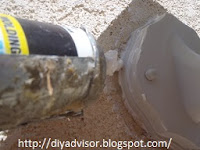 |
| Fig.1 5-lb coffee |
Tools and Supplies:
Creamy Hawaiian Hazelnut Coffee
Keurig™ K55 Single-Serve Coffee Maker
Ground Coffee
Poly Flow K-cups
Scissors
K-cups are all the rage if your talking about individual size serving. This post shows what we used to drink and what we drink now and why.
This post shows the four steps to show the difference between drip coffee and Keurig™ K55 Single-Serve Coffee Maker using K-cup.
Step 1: Fig.1 through fig.3 shows that this creamy Hawaiian hazelnut coffee that we used to drink everyday. We purchased it at Sam's Club™ and it made our day. We used to brew a 12-cup (2.838 liters) carafe every morning until we received a Keurig™ K55 has a gift from our family. Fig.2 and fig.3 shows our coffee of choice and we used a cup of ground coffee per day.
 |
| Fig.2 Ground coffee |
 |
| Fig.3 Measured |
 |
| Fig.4 Eco-Fill™ K-cups |
 |
| Fig.5 Eco-Fill™ Directions |
 |
| Fig.6 - 2 teaspoons = 10 grams |
 |
| Fig.7 Brown and green |
 |
| Fig.8 |
 |
| Fig.9 |
 |
| Fig.10 |
 |
| Fig.11 All Eco-Fill™ K-cups Filled with Regular Ground coffee |
Step 4: Brewing. Fig.12 through fig.15 shows each serving of coffee pods fill one cup with delicious coffee.
 |
| Fig.12 Keurig™ K55 |
 |
| Fig.13 K-cup pods |
 |
| Fig.14 Starbucks™ Coffee cup |
 |
| Fig.15 Delicious coffee |
Step 4: Now why we changed. We enjoy our coffee pods, we use less coffee and make less of a mess. We started purchasing our creamy hazelnut coffee at Sam's Club. Eventually Sam's Club stopped carrying our brand, so now we purchase it from the Internet. We pay about 34-cents per cup and for us this fits our budget.
Our Math: We used to purchase Copper Moon World Coffees, Hawaiian Hazelnut (2.5 lb. = 1.134 kg) $15.00 which made over 21 pots of coffee.
Fig.16 shows Gaza Trail™ Creamy Hazelnut coffee K-cup pods is what we both drink now for our daily coffee. It is a treat everyday.
Our Math: We used to purchase Copper Moon World Coffees, Hawaiian Hazelnut (2.5 lb. = 1.134 kg) $15.00 which made over 21 pots of coffee.
- 2.5 lbs of coffee = 40 oz = 205 cups / 12 cup carafe = 17.1 pots of coffee. Our coffee lasted 3-weeks. So we made it weaker than this table states.
- Each approved Keurig K-Cup Pods = 2 teaspoon = 10 grams for a 6 to 8 oz of brewed coffee.
- Regular grocery ground coffee costs about 5-cents per cup and paying 0.35 cents Gaza Trail™ Creamy Hazelnut coffee K-cup pods.
- So maybe we are paying 30 cents more for our special brew of coffee, but for us it is worth it.
- Each brand of K-cup have different quantity of coffee. You have to decide what your budget is to determine if you have to drink 5 cent coffee or spoil yourself and spend 35 cent coffee.
Fig.16 shows Gaza Trail™ Creamy Hazelnut coffee K-cup pods is what we both drink now for our daily coffee. It is a treat everyday.
 |
| Fig.16 Gaza Trail™ |
Caza Trail Coffee, Creamy Hazelnut
- Single serve cups compatible with Keurig 1.0 K-Cup Brewers 2-teaspoon, each box has 100 serving.
- From Latin America
- Creamy, nutty flavored light roast with a delicate body, mild acidity and sweet aroma
- Kosher certified
Interesting Internet Links:
- Keurig Blog, this blog provides many choices of social pages, including Facebook, Pinterest, and others.
- Convert teaspoons to grams, conversion of measurement units
- K-Cup Economics - Comparing Coffee Costs with Keurig, published July 10, 2015. Excellent article on both brewed coffee and K-cup coffee.
- Save 61% by brewing coffee with a K-Cup reusable filter, This article shows all the facts about each K-cup reusable pods with ground coffee compared to standard K-Cup Pods available anywhere. The article explain in detail why you should switch to save the environment and to save cash, written by Kerry K. Taylor
- Single-serve coffee container
- Get a STRONGER Brew from your My Kcup. Interesting article that shows how to make a stronger brew of coffee using an existing pod along with reusable K-cup filter pod.
- The Ultimate Guide to Keurig K-cup Coffee Brewing goes directly to your computer. This E-book show tip and tricks on how to clean and use the Keurig. These directions come from Cross Country Cafe
Update: DIY Advisor has New blogs check them today:
- Handyman Blog: DIY Advisor
- DIY Advisor Sitemap
- Food Blog: From Kiwis To Pistachios
- Food Blog Sitemap
- Tool Blog: DIY Advisor Toolbox
- Tool Blog Sitemap
- Artwork Blog: Light in Dark Artwork
- Artwork Blog Sitemap
- Class-A Tests: DIY Class-A Drivers License Tests
- Class-A Tests Sitemap: Class-A Sitemap
- DIY Poem: DIY Poem Meter Blog
- DIY Poem Sitemap: DIY Poem Sitemap
- Cookie Alert: European Union laws requires that you know that this blog uses cookies. If you are concerned about this please click here to see how Google uses this information.
Note: The DIY Advisor assumes no liability for omissions, errors or the outcome of any jobs. The reader must always exercise reasonable caution, follow current codes and regulations that may apply, and is urged to consult with a licensed contractor if in doubt about any steps on these posts. All names were changed to protect client's privacy. DIY Advisor. Reproduction of site content including photos without permission prohibited. All rights reserved. © Copyright 2011-





































